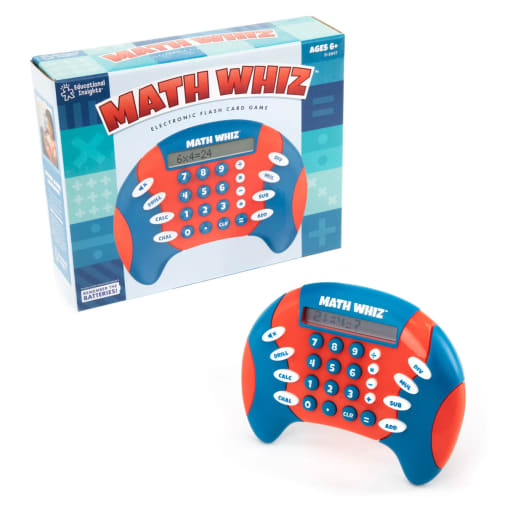Math Whiz® provides a versatile math tool that will help you practice math facts and also works as a calculator. Students can drill addition, subtraction, multiplication, and division facts at 8 different levels. Practice facts 0-9 in addition and subtraction, 0-12 in multiplication, and 1-12 in division. Each time a problem is answered, children will see a smiling face and tone if correct and frowning face with an audible beep if incorrect. The calculator can be used for the four basic functions. The Challenge' function is a number game in which you must quickly find digits that add up to ten (in 5 difficulty levels). Requires two AAA batteries, not included. ~ Donna
Math Whiz
SKU
013569
Grade 1-4
These icons are designed to help you quickly understand and learn important information about our products.
Teaching Method
Traditional
Teacher-centered curriculum commonly used in classrooms that may include a text, teacher manual, tests, etc.
Charlotte Mason
A methodology based on the work of a 19th century educator who maintained that children learn best from literature (Living Books), not textbooks.
Classical
A methodology based on the Latin Trivium (three stages of learning), including the grammar stage (memorization and facts), logic stage (critical thinking), and rhetoric stage (developing/defending ideas).
Unit Study
A thematic or topical approach centered around one topic that integrates multiple subject areas.
Montessori (Discovery)
A methodology based on the work of a 20th century educator that emphasizes student and sensory-driven discovery learning and real-life applications.
Other
Other methodologies
Religious Content
Secular
Contains content contrary to common Christian beliefs (i.e. evolution).
Neutral
Avoids religious or theoretical topics or presents multiple viewpoints without preference.
Christian/Religious
Faith-based or including instructional religious content.
Learning Modality
Auditory
Learns through listening, talking out loud or reading out loud.
Visual
Learns through seeing, prefers written instructions and visual materials.
Kinesthetic/Tactile (Hands-On)
Learns through moving, doing and touching.
Multi-Sensory
Curriculum that employ a variety of activities/components.
Presentation
Sequential
Curriculum progresses through well-defined learning objectives. Emphasizes mastery before moving to the next topic.
Spiral
Topics and concepts are repeated from level to level, adding more depth at each pass and connecting with review.
Conceptual/Topical
Focus is on the “why,” often with a unifying concept as well as specific skills; coverage may be broader.
Teacher Involvement
Low Teacher Involvement
Student-led materials; parent acts as a facilitator.
Medium Teacher Involvement
A mix of teacher-led time and independent student work.
High Teacher Involvement
Teacher-led lessons; may utilize discussions, hands-on activities and working together.
Additional Materials Required
No other materials needed
Everything you need is included.
Other Materials Required
There are additional required resources that are a separate purchase.
Other Materials Optional
There are additional resources mentioned or recommended but are not absolutely necessary.
Consumable
Consumable
Designed to be written in; not reusable.
Non-Consumable
Not designed to be written in; reusable.
Our Price
$31.99 $31.99 $28.95
Rainbow Savings: $3.04
Description
Publisher's Description of Math Whiz
The Big Idea
Mini mathematicians can practice addition,
subtraction, multiplication, and division with this electronic math game
featuring eight increasingly difficult levels and three modes. Bonus: converts
to a full-function classroom calculator.
Psst…They’re Learning!
- Includes 3 modes of play: Drill Mode (progressively more difficult sequence of problems), Challenge Mode (a number elimination game), and Calculator Mode
- Encourages independent learning
- Perfect for practice on the go
Cut to the Chase
- Activities include addition & subtraction, multiplication & division, and problem solving
- Converts to a full-function calculator
- Math Whiz requires 2 AA batteries (not included)
Grades 1+/Ages 6+
Details
| Product Format: | Other |
|---|---|
| Grades: | 1-4 |
| Brand: | Educational Insights |
| EAN/UPC: | 086002088970 |
| Length in Inches: | 6.125 |
| Width in Inches: | 7.625 |
| Height in Inches: | 1.9375 |
| Weight in Pounds: | 0.7 |
Videos
Reviews

